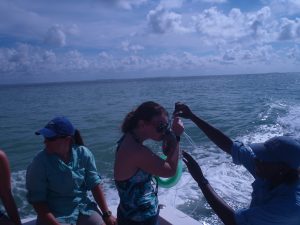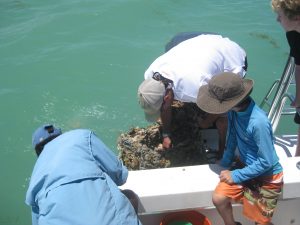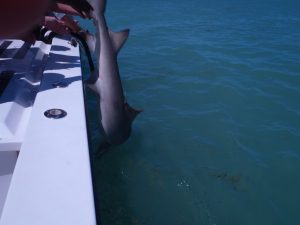Just Another Day Sharkin’
Saturday, June 18th 2011
The first set of the summer trips had arrived and it felt way too long since the last time we were out doing shark research! The day was picture perfect at Keys Marine Lab and we were able to bring out a group from Deering Estates and also some new interns, aka “newbies,” to join in our adventure for the day. After everyone had settled in and instructions were given, it was off to Everglades National Park to set the drumlines in the water. To increase our chances, we made each of the students putting in a drumline kiss the bait for an extra bit of good luck. At first they were a bit skeptical, but got the hang of our superstitions rather quickly!

Student from Deering Estates lays a fat one on the bait for an extra pinch of good luck. Click to enlarge.
After putting the drumlines in quite fast, the infamous “10 drumlines in the water” phrase was yelled and it was now off to rest and relax before the hard work began. Getting ready for the first set there was excitement building in the air. “Did kissing all our bait really bring us more luck?” As the first line of the day was being brought in, we were about to find out. There was tension right away as the line was spooled in and beheld at the end was a nice female blacktip, approximately 158 cm long. Starting off on such a high note, the students and the “newbies” buzzed while bringing in the other nine drumlines. Unfortunately, there were no other sharks on our lines for the rest of the first set. Would the second set bring us more sharks? Hopefully.
Just like in the first set, one shark was caught on the second set. It was a female lemon shark whose total length was 208 cm. Along our second shark of the day, we were also able to bring up a ghost crab trap that had gotten tangled in our line. Covered with tunicates and sponges, the students had a chance to look and explore makeshift habitats for other marine organisms.

Interns pull up a ghost crab trap, a forgotten or lost trap left in the ocean. Ghost traps can be hurtful to the environment when tousled or dragged by strong weather or boats, but may also provide a makeshift habitat for sessile and aggregative animals, like those shown encrusted on the trap in the picture above. Click to enlarge.
Finishing up our second set and including our third, we did not have the chance to bring up any sharks. However, on our fourth and final set, we were able to get two more – a female blacktip, around 148 cm, and a male lemon shark that was a total length of 204 cm. The male lemon was deemed to be a bit more special than all the others due to the fact that he was a recapture that had been at large in the water for 813 days! The area we were in, allowing us to resurvey him, was also within the general area in which we first tagged him in March of 2009. When the lemon was first tagged, it was around 186 cm and grew 18 cm over the course of the time he was at large (almost 2 years). The original roto tag on the dorsal fin was missing, but a mark in the fin was still present where it had once been placed. Although the dart tag in the musculature at the base of the dorsal fin was still present, it was removed and replaced with a new one. Our recapture rate is only about 2%, if that, so we were ecstatic to get this male lemon and find him in such great condition, with no signs of damage from the initial set of tags, nor from today’s, and send him off on his way again.

Bye bye lemon, until next time! Interns release a healthy recaptured male lemon shark after being resurveyed. Click to enlarge.
All in all there were a total of four sharks caught, with one being a recapture. It was great to get on the water again and also good to have a new group of interns and students joining the experience. Hopefully this great start of a weekend will lead a summer full of awesome trips and good times just like it!
Elasmobranch love,
Julia Lampe (RJD Shark Intern)

It is good to release those lemon sharks. But sad letting it go at the same time. Such magnificent creatures!